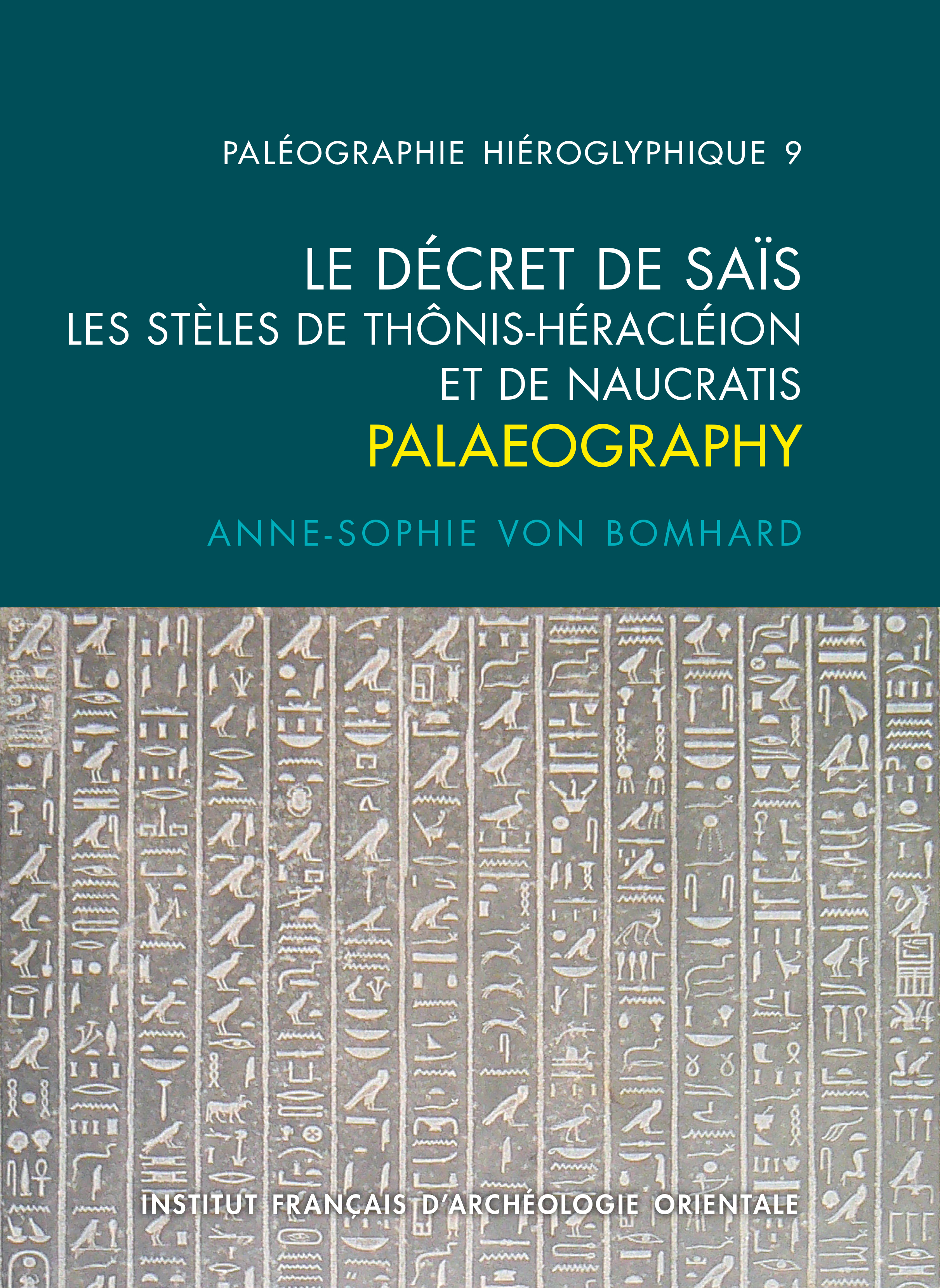Catalogue des publications
- Pour effectuer une commande, remplissez votre panier puis terminez votre commande. Vous pourrez effectuer un paiement sécurisé et être livré dans le monde entier. J’ai un code promotionnel
- To perform an order, fill your cart then proceed the order. You will be driven to a secured page for the electronic payment which includes worldwide shipping fees. I have a promotional code.
Prochainement
IF1373
ISBN 9782724710960
2025 IFAO
Collection: PalHiero 9
Langue(s): français
1 vol. 254 p.
Anne-Sophie von Bomhard
Le décret de Saïs
Les stèles de Thônis-Héracléion et de Naucratis
Remontée en 2001 du fond de la mer Méditerranée où elle gisait depuis plus de 2000 ans, une grande stèle de granodiorite noire a été mise au jour sur le site de Thônis-Héracléion, l’ancien port de la bouche canopique entièrement submergée aujourd’hui.
Les représentations et le texte du « décret de Saïs » qu’elle porte nous sont connus par un monument similaire trouvé un siècle auparavant : la stèle de Naucratis. La stèle de Thônis-Héracléion présente toutefois l’intérêt de révéler le nom égyptien complet de la localité à laquelle elle était destinée, « La-Hôné-de-Saïs », qui n’était pas attesté jusque-là.
Ces deux monuments, gravés de hiéroglyphes de belle qualité et parfaitement conservés, sont l’occasion de procéder à l’étude paléographique d’un décret promulgué par Nectanébo Ier, au cours de sa première année de règne, dans le temple de Neith à Saïs. La mise en parallèle des deux exemplaires montre la manière personnelle dont chacun des graveurs a reproduit ce document, manifestement établi par un haut lettré du temple de Saïs. Le choix des hiéroglyphes et leur agencement, la recherche de variétés au moyen de dissimilations graphiques et iconiques, tout s’inscrit dans la tradition des écritures à plusieurs niveaux de lecture, dites « difficiles », particulièrement appréciées à l’époque saïte, mais aussi sous le règne des Nectanébo.
In 2001, a large black granodiorite stele was recovered from the bottom of the Mediterranean Sea, where it had lain for over 2,000 years. It was found at the site of Thonis-Heracleion, the ancient port at the mouth of the Canopic River, which is now completely submerged.
The representations and text of the “Decree of Sais” it bears are known to us from a similar monument found a century earlier: the Naucratis stele. The Thônis-Héracléion stele, however, has the advantage of revealing the full Egyptian name of the locality for which it was intended, “La-Hôné-de-Saïs”, which had not been attested until then.
These two monuments, engraved with perfectly preserved, high-quality hieroglyphs, provide an opportunity to carry out a paleographic study of a decree promulgated by Nectanebo I, during his first year of reign, in the temple of Neith at Saïs. Placing the two copies side by side shows the personal way in which each of the engravers reproduced this document, clearly drawn up by a literate high priest at the temple of Sais. The choice of hieroglyphs and their arrangement, the search for variety through graphic and iconic dissimilations—all this is in keeping with the tradition of writing with several levels of reading, known as “difficult”, particularly appreciated in the Saite period, but also under the reign of the Nectanebo pharaohs.
تم استخراج لوحة كبيرة من الجرانوديوريت الأسود من قاع البحر المتوسط حيث كانت قابعة لأكثر من ألفيّ عام وتم الكشف عنها في موقع ثونيس-هيراكليون، الميناء القديم للمصب الكانوبي الذي أصبح مغمورًا بالكامل الآن. والواقع إن المناظر ونص "مرسوم سايس" اللذان تحملهما اللوحة معروفان لنا من لوحة نقراطيس؛ وهو أثر مماثل عُثر عليه قبل قرن من الزمان. ومع ذلك، تمتاز لوحة ثونيس-هيراكليون بالكَشْف عن الاسم المصري الكامل للمنطقة التي كانت فيها؛ وهي "La-Hôné-de-Saïs"، والذي لم يكن معروفًا من قبل. يتيح هذان الأثران، المنقوشان بالهيروغليفية عالية الجودة والمحفوظة بشكل مثالي، فرصة لدراسة الكتابة القديمة لمرسوم أصدره نختنبو الأول خلال السنة الأولى من حكمه في معبد نيت في سايس. وتُظهِر المقارنة بين النسختيْن الطريقة الشخصية التي استنسخ بها كل واحدٍ من النقاشين هذه الوثيقة، والتي من الواضح أن أحد كبار العلماء في معبد سايس قد قام بصياغتها. كما يُشَكِّل اختيار العلامات الهيروغليفية وتنسيقها، والبحث عن التنوع عن طريق الاختلافات التخطيطية والتصويرية، جزءًا من تقاليد الكتابات ذات القراءة متعددة المستويات، والمُسماة باﻟ"الصعبة"، والتي حَظِيَّت بتقدير خاص في العصر الصاوي، وكذلك في عهد نختنبو.
- Anne-Sophie von Bomhard
Anne-Sophie von Bomhard est membre de l’Institut européen d’archéologie sous-marine. Ses recherches portent sur des artéfacts issus de fouilles sous-marines, mais aussi sur l’écriture, ainsi que sur le calendrier et l’astronomie en Égypte ancienne.


